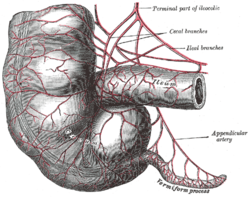虫垂
Japanese

| Kanji in this term | |
|---|---|
| 虫 | 垂 |
| ちゅう Grade: 1 |
すい Grade: 6 |
| kan'on | |
| Alternative spelling |
|---|
| 蟲垂 (kyūjitai) |
Etymology
Appears to be a coinage in Japanese as a compound of 虫 (chū, “worm”) + 垂 (sui, “appendix (anatomy)”), replacing earlier 虫様突起 (chūyō tokki, “vermiform process”).[1]
It seems that the 突起 (tokki, “protrusion; protuberance; process”) portion in the older term was first replaced with 垂 (sui, “dangling; hanging (from something); appendix”) as 虫様垂 (chūyō sui, literally “worm-shaped dangling → vermiform appendix”), which in turn was shortened to modern 虫垂 (chūsui).
Compare Dutch wormvormig aanhangsel, English vermiform appendix.
Pronunciation
Lua error in Module:ja-pron at line 78: Parameter "yomi" is not used by this template.
Noun
- (anatomy) an appendix, a vermiform appendix
Usage notes
In informal usage, the term 盲腸 (mōchō) is more common. In medical contexts, 虫垂 (chūsui) is preferred, as 盲腸 (mōchō) refers more specifically to the caecum instead of the appendix.
Derived terms
References
- ^ Kindaichi, Kyōsuke et al., editors (1997), 新明解国語辞典 [Shin Meikai Kokugo Jiten] (in Japanese), Fifth edition, Tokyo: Sanseidō, →ISBN
- Japanese terms spelled with 虫 read as ちゅう
- Japanese terms spelled with 垂 read as すい
- Japanese terms read with kan'on
- Japanese compound terms
- Japanese lemmas
- Japanese nouns
- Japanese terms spelled with first grade kanji
- Japanese terms spelled with sixth grade kanji
- Japanese terms written with two Han script characters
- ja:Anatomy
